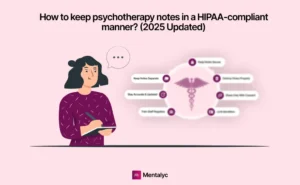Psychological trauma in children doesn’t always show up in the ways we would expect. Sometimes, children may have typical responses, like nightmares, panic attacks, or mood swings. Other times, they appear to be just fine, but a noticeable shift follows. They start isolating themselves from their friends; their academic performance declines, and the little things that used to be shrugged off quickly take a toll on them, revealing signs of something greater at play. This is why early intervention for trauma is crucial. The earlier we can find and treat it, the better chance our clients have of working through their trauma before it impacts their behaviors, emotions, and cognitive development. This is where the Trauma Symptom Checklist for Children, or TSC, comes in handy.
While the TSC is not a diagnostic tool for PTSD, it is a tool that allows us to understand our clients better. We know that children don’t always have the words to describe their feelings or the extent of their pain. That’s why implementing the TSC assessment can help clinicians screen children and adolescents for signs of trauma, giving a clearer picture of what children may be dealing with underneath the surface. Through the TSC’s thoughtful questions, clinicians can identify individual responses to trauma, allowing them to develop treatment plans that meet each client’s needs.
What is the Trauma Symptom Checklist (TSC) for Children?
The TSC is a commonly used measure of trauma symptoms in children aged 8 to 16 years old. It serves as a tool for mental health clinicians to identify the emotional, behavioral, and cognitive expressions of trauma, with the ultimate aim of informing treatment plans and providing tailored care for each child.
Key Symptoms Assessed by the TSC
Think of the TSC as a detective’s magnifying glass, ever so closely examining how a traumatic event has affected a child. It breaks down symptoms into three crucial areas:

New! Transfer your notes to EHR with a single click. No more copy-pasting.
- Emotional Symptoms: Are they struggling with anxiety, falling into despair, or frozen by terror? Are they getting angry or emotionally withdrawn?
- Behavioral Symptoms: Are they suddenly becoming aggressive? Are they withdrawing from friends and family? Are they injuring themselves or acting in regressive behaviors like bedwetting or being overly clingy?
- Cognitive Symptoms: Are they struggling to concentrate, losing their problem-solving ability, or having trouble thinking ahead? Are lapses in their memory becoming more frequent and making them frustrated?
By breaking down each category, the TSC provides practitioners with a thorough understanding of the impact trauma has had on their clients’ daily lives and their emotional states following the traumatic event.
Sample Questions from the TSC
The TSC asks questions to help trace the overlapping aspects of trauma symptoms and deepen our understanding of the child’s mental and emotional state. Here are a few sample questions:
Emotional Symptoms:
- “How often do you feel scared without knowing why?”
- “Do you sometimes have trouble feeling happy?”
Behavioral Symptoms:
- “Are there certain people or places you avoid because they remind you of bad memories?”
- “Are you prone to sudden outbursts of anger?”
Cognitive Symptoms:
- “Do you struggle with focusing on schoolwork or other tasks?”
- “Are recurring nightmares a part of your sleep?”
The TSC: A Tool in Action
When using the TSC, follow a standardized approach. This ensures that your results are reliable and comparable across different cases.
Helping Kids Feel Comfortable with the TSC
Children are more likely to respond truthfully when they feel safe. Whether they fill out the TSC independently or go through it with you, ensure the process is as easy as possible.
Here is what helps:
- Keep it simple. Use words they understand when explaining why they’re doing this.
- Let them set the pace. Don’t rush if you’re reading the questions; give them time and space to answer.
- Be there for them. Some questions might bring up feelings. Let them know it’s okay and they’re not alone.
Decoding the Scores
Each item is rated on a scale of 0 (Never) to 3 (Often), reflecting the rate of trauma-related distress. While cut-off scores may be specific, standard guidelines are:
- Mild (0–10): Low levels of distress; may only require monitoring rather than immediate treatment.
- Moderate (11–25): High distress; more assessment and therapeutic intervention should be conducted.
- Severe (26+): High levels of distress related to trauma; immediate, trauma-informed treatment should be provided.
While the TSC is highly informative, it is not a standalone diagnostic tool. Scores should always be interpreted within the broader clinical context.
Interpreting Scores within a Clinical Context
TSC results need to be evaluated among norms for your client’s gender and age while also considering other parameters:
- Symptom Clusters: Check for consistency in emotional, behavioral, and cognitive symptoms.
- Developmental Context: Distinguish age-typical responses from responses rooted in trauma.
- Cultural Factors: Be sensitive to differences in cultural patterns of expression and coping.
Peeling Back the Layers: TSC’s Validity, Reliability, and Limitations
The TSC for Children has been carefully honed for reliability and validity:
- Validity: Research confirms TSC effectively distinguishes traumatized children from non-traumatized ones, rightly assessing trauma symptoms.
- Reliability: Test-retest analyses demonstrate stable results over time, making the checklist a dependable tool for tracking progress in trauma therapy.
On The Other Hand…
While the TSC is a valuable assessment tool, it’s essential to address its limitations:
- Self-Report Bias: Young children or those with communication challenges could inaccurately express feelings.
- Cultural Sensitivity: The questions might overlook cultural variations in trauma expression and coping procedures.
- Parameter Overlap: The TSC can’t do everything. Combining it with clinical interviews, caregiver inputs, and other assessment tools will give a better, rounded view.
Employing the TSC: Best Practices & Ethical Considerations
Practitioners handling the TSC must stick to ethical best practice guidelines, such as:
- Informed Consent: Be clear. Your client and their parents or caregivers must thoroughly know the test, why you think it is appropriate for the situation, and how it works before doing it.
- Mandatory Reporting: Stay alert to any signs of harm or neglect. Reports must follow legal rules.
- Trauma-Sensitive Care: Sensitivity is essential while navigating distressing revelations. Avoid re-traumatization during the test process.
- Bias Awareness: Noticing potential bias is fundamental to avoid skewing interpretation or approach.
- Reducing Distress: Techniques to ground the child during the TSC stave off stress.
Conclusion
The Trauma symptom checklist is an invaluable tool for identifying and addressing trauma-related symptoms in our young clients. Assessing emotional, behavioral, and cognitive responses supports early intervention, personalized treatment, and long-term progress tracking. While reliable, the TSC is most effective alongside other assessments to meet each child’s mental health needs fully.
For clinicians looking to streamline their assessment process and improve documentation efficiency, Mentalyc offers AI-powered solutions tailored for mental health professionals. Simplify your workflow and focus on delivering trauma-informed care with precision. Explore Mentalyc today to enhance your clinical practice.
FAQ on the TSC for Children
Who can administer the TSC?
The TSC should be administered by mental health clinicians who work with children who have experienced trauma.
Can the TSC be used for younger children?
TSC is tailored for children aged 8 to 16; however, the TSCYC (Trauma Symptom Checklist for Young Children) is a more appropriate tool for younger children aged 3 to 12.
How is the TSC administered?
The TSC can be given in a self-report instrument in which children answer a battery of questions about their symptoms of trauma or in a one-on-one interview with their mental health provider.
How does the TSC help in treatment planning?
The TSC references specific trauma symptoms, which helps clinicians understand the child’s experiences and what emotional responses are taking place. This knowledge is fundamental to the individualization of a treatment plan to address the trauma characteristics most salient to the child and promote healing.
Can the TSC be used for ongoing monitoring of recovery from trauma?
Yes, you can do the TSC whenever you want. The more tests, the easier changes in the severity of the symptoms, whether treatments are effective or not, and if plans need to be altered can be seen.
How long does it take to complete the TSC?
Children usually complete the TSC in 15-20 minutes. This assessment is straightforward and age-appropriate, so children complete it without becoming overwhelmed or frustrated.
How often should the TSC be administered?
Depending on the child’s needs and treatment plan, TSC can be given as infrequently as every three weeks or more frequently. Some practitioners may use the tool as an intake assessment, while others may administer it regularly over time to assess progress.
Why other mental health professionals love Mentalyc

“It’s so quick and easy to do notes now … I used to stay late two hours to finish my notes. Now it’s a breeze.”
Licensed Professional Counselor

“By the end of the day, usually by the end of the session, I have my documentation done. I have a thorough, comprehensive note … It’s just saving me hours every week.”
CDCII

“Having Mentalyc take away some of the work from me has allowed me to be more present when I’m in session with clients … it took a lot of pressure off.”
LPC

“It takes me less than 5 minutes to complete notes … it’s a huge time saver, a huge stress reliever.”
Licensed Marriage and Family Therapist






